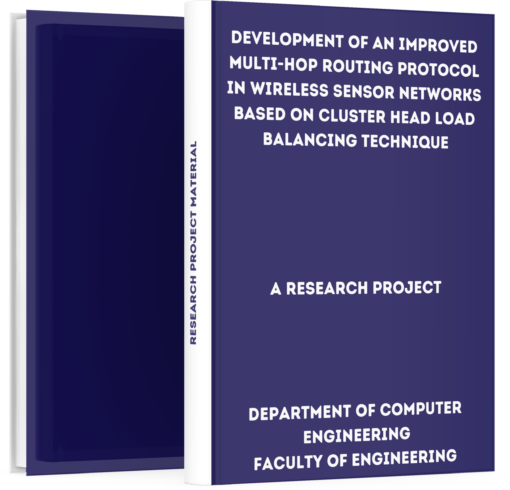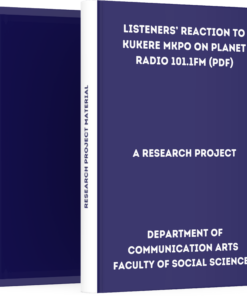Development of an Improved Multi-Hop Routing Protocol in Wireless Sensor Networks Based on Cluster Head Load Balancing Technique
₦3,000.00
If you are interested in getting this project material “Development of an Improved Multi-Hop Routing Protocol in Wireless Sensor Networks Based on Cluster Head Load Balancing Technique”, click on the DOWNLOAD BUTTON to make payment and the file will be delivered to your email immediately after confirmation.
Description
– Development of an Improved Multi-Hop Routing Protocol in Wireless Sensor Networks Based on Cluster Head Load Balancing Technique –
Download Development of an Improved Multi-Hop Routing Protocol in Wireless Sensor Networks Based on Cluster Head Load Balancing Technique. Computer Engineering students who are writing their projects can get this material to aid their research work.
Abstract
Energy conservation in wireless sensor networks (wsns) is a key area of research aimed at addressing the challenge of efficient energy utilization. This is due to the fact that the sensor nodes (sns) have limited energy. The limited energy has to be utilized efficiently in order to provide a longer network lifetime for the wireless sensor network (wsn).
To reduce energy consumption in wsns, an improved multi-hop routing protocol (meemrp) in wsns based on cluster head (ch) load balancing technique was developed in this research work.
The protocol used the residual energy (re) of cluster heads (chs) and adopted an election energy threshold (tnhch) to reduce the energy consumption of the sns in the network, thereby increasing the network lifetime.
Introduction
A Wireless Sensor Network (WSN) is a network that is composed of hundreds of sensor devices that communicate over wireless channels (Vijayan & Raaza, 2016). This communication is governed by unique routing protocols (Vijayan & Raaza, 2016).
The sensors are equipped with data processing and communicating capabilities with a sensing circuitry that is able to sense environmental conditions such as temperature, pressure, humidity levels, etc, and convert them to electrical signals.
These conditions help to tell certain details about the surrounding environment. The sensors transmit their sensed data via an inbuilt transmitter as electromagnetic signals to a designated base station (BS) either directly (Akkaya & Younis, 2005) or through an intermediate node (Gupta et al., 2017).
How to Download this Project Material
First, note that we are one of the best and most reliable online platforms because we don’t retain any of your personal information or data as regards making payments online.
PRICE: ₦3,500 ₦3,000 (Three Thousand Naira Only)
Make a bank deposit or mobile transfer of ₦2,000 only to the account given below;
Bank Name: UBA Account Number: 1022564031 Account Name: TMLT PRO SERVICES
After making the payment, CLICK HERE to send the following on WhatsApp;
- Depositor’s Name or Screenshot of Payment
- Name of the Past Question
- Active Email Address
or Call Us On +2348082284439 Once your details have been received and your payment confirmed by us, you will receive the past question in your email or WhatsApp within 5 Minutes.
Guarantee of Getting the Material
We understand that due to the high rate of fraud, many people are afraid of making purchases online but be rest assured that PastExamQuestions will deliver your material after payment.
Once your details have been received and your payment confirmed by us, you will receive the past question in your email or WhatsApp.
Give us Feedback
Have we been able to satisfy you? How well do you think the material will be helpful after having gone through it? Does the price worth the material?
Let’s hear from you! We recommend that our customers give feedback at the end of every transaction to enable us to serve better. You can do this by clicking the review button on this page.
Where is the review button? >> Just scroll up to where you see reviews





Reviews
There are no reviews yet.